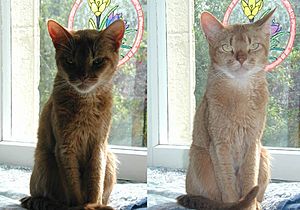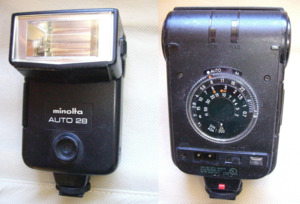Flash (Camera) facts for kids
A camera flash, also called a strobe, is a cool device used in photography. It helps you take pictures in dark places by making a super bright, quick burst of light. Imagine trying to snap a photo in a dimly lit room – a flash makes sure your picture isn't just a blurry, dark mess!
Flashes are often built right into your camera, like on your phone or a compact digital camera. But there are also external flashes. These are separate units that professional photographers often use. They can attach to the top of a camera or even be used off to the side on a stand.
Contents
What is a Camera Flash?
A camera flash gives off a very bright light for a tiny moment. This quick burst of light helps to properly light up whatever you are taking a picture of. Using a flash to take photos is generally known as flash photography.
Why Do We Need a Flash?
You might think, "Why not just use a lamp?" Well, a flash is special because it's super bright and very fast. This speed helps to "freeze" motion, so your pictures don't look blurry, even in low light. It also makes sure the whole scene is lit evenly.
Types of Flashes
There are two main types of camera flashes:
- Built-in flashes: These are small flashes found on many cameras, including smartphones. They are convenient and easy to use.
- External flashes: These are bigger and more powerful. They can be attached to a camera or used separately. Professional photographers often use them for more control over the light.
How Does a Camera Flash Work?
Modern camera flashes use special technology to create that bright light. Most flashes use a type of tube called a xenon flashtube. When electricity quickly flows through this tube, it makes a very bright, mostly blue light. Some newer flashes also use tiny LED lights.
A Quick Look at Flash History
Flashes have been around for a long time!
- Early flashes: In the late 1800s, photographers used a stick with magnesium powder on top. When lit, it made a very bright flash. Someone had to hold the stick while the picture was taken!
- Flashbulbs: Later, special light bulbs called flashbulbs were invented. These bulbs would light up once and then had to be replaced.
- Modern flashes: Today's electronic flashes are much safer and can be used many times.
When to Use a Flash
A flash is super helpful in many situations:
- In dark places: If you're taking a picture indoors at night or in a dimly lit room, a flash can light up your subject.
- For "fill-flash": Sometimes, the light behind your subject is too bright, making them look like a dark outline. A "fill-flash" adds light to the front of your subject, balancing the light. This is what happened with the cat picture above!
- To freeze motion: The quick burst of light can help capture fast-moving things without blur.
Where Can't You Use a Flash?
Even though flashes are great, there are some places where you should not use them:
- Museums and art galleries: The bright light from a flash can slowly damage old paintings, photos, or delicate objects. It can also be annoying to other visitors.
- Zoos or aquariums: Flashes can scare animals or disturb them.
- Live performances: Using a flash at a concert or play can be very distracting for the performers and the audience.
- Near sensitive equipment: In some scientific or medical settings, flashes might interfere with delicate instruments.
Always check for signs or ask if you are unsure whether flash photography is allowed!



